Refreshing Vancouver and the Canadian Rockies in 2019
(Travel Story Series @ Hon Too Fang 2021)
Introducing Canada
Canada is a huge country in area, in fact she is the 2nd largest country in the world, about 30 times bigger than Malaysia. The population is 38 million, made up of more than half with British origins, followed by the French, Germans, Chinese, Italians and Indians. The indigenous First Nations constitutes about 5%. Population continues to grow via immigration, mostly from the Asian countries of India, China and the Philippines. English and French are the official languages.
Politically Canada is a parliamentary democracy and a constitutional monarchy, like Malaysia. Administratively it is divided into 10 provinces and 3 territories. The capital is Ottawa with a city population of near to a million. Canada has an advanced economy, the principal industries are services, manufacturing and mining.
Our tour in Canada
We, a group of 4, had a very limited tour of the vast country. In fact we just visited the cities of Vancouver and Victoria in the province of British Columbia and joined a coach tour to the Canadian Rockies. In between we took the Alaska Cruise starting/ending at Vancouver.
Vancouver
Vancouver has a city population of 650,000. 30% of the population in the inner city is Chinese, making them the largest ethnic group. It is a port and gateway to the popular Alaska Cruises and the starting/ending point for coach tour to the Canadian Rockies. It is a top-rated city for liveability and quality of life.
Waterfront
The 3 km long waterfront, most part of it "equipped" with designated pedestrian walkway, is a tourist attraction on its own merit. Near the eastern end is the sail-shaped building, the Canada Place, housing the cruise ship terminal, hotels, etc. Nearby is the unique 20-m tall steel sculpture called "The Drop". On the sea side are the yachts and seaplanes.
Dotting the walkway are shops, bicycles for rent, and a sculpture called “Lightshed” erected in 2006. Near the western end is the Devonian Harbour Park, with spring flowers in bloom. The bushy green-yellow plant in the 5th photo is the Albanian Spurge. And on the land side are offices and high-end residences.
Gastown
The oldest part of the city is called Gastown, with brick buildings restored to the Victorian era, cast iron lamps, and the whistling Steam Clock. The statue is that of Gassy Jack (1830-1875) who put up the 1st building at the subdivided plot of land. The last photo shows Hotel Europe, built on a triangular plot of land, the so-called “Flatiron” style.
(Note in 2021: in 2020 the Gassy Jack statue was defaced and there was a petition by the indigenous First Nations people to the city council to remove this statue as Gassy Jack was considered not a good man worthy of a monument.)
Robson Square
Robson Square is a landmark civic centre and public plaza located in downtown. It is the site of several government offices, like the Provincial Law Court in the 1st photo and the Vancouver Art Gallery in the 2nd photo. The bronze sculpture in the 3rd photo is called “Bird of Spring” installed in 1979. White azaleas are in bloom here.
Chinatown
The old Chinatown bordering Gastown is the largest in Canada. However it is losing its position as newer and richer immigrants from China, including those from Hong Kong, are now settling in the new suburb of Richmond where the people of Chinese origins are said to reach 50%.
Shown a street scene in the old Chinatown and a shoe repair shop in a small shopping centre. The other photos were taken at the Dr Sun Yet-Sen Classical Chinese Garden where the pink peony and the rare purple azaleas are in bloom.
The next 2 photos were taken at the Richmond night market. There are certainly many Chinese faces. And a lot of spiralling chips too. Must add here that the night market is open for about 5 months from late spring to late autumn when the weather is good. Open only on Fridays to Sundays. And we need to pay about RM 15 for entry, certainly a surprise to my Malaysian readers.
Granville Island
Granville is not an island but a peninsula under the Granville Bridge where the so-called public market is a good place for shopping and food, etc. It is within walking distance from downtown. We in fact walked there. The 1st photo shows the view of yachts in the water surrounding the peninsula, taken from the Granville Bridge. Vancouver is an affluent city.
Colourful buildings and colourful merchandise. The spongy thing in the 5th photo are cakes. And lastly, a beaming old lady and blooming young tulips vie for attention of the photographer.

Stanley Park
Stanley Park is Vancouver’s largest park, a top tourist attraction and a designated National Historic Site. It is an extension of the waterfront. The park covers 400 hectares with rainforest, low mountains, coastlines and the park’s seawall. Most of it is still heavily forested. We were here on 2 occasions, first by foot over a part of the park and the 2nd time rented bicycles to cover the whole park via the seawall route, about 10 km.
The park has a group of 9 totem poles to honour the original natives living here. Shown with travel companion CL, the pole on the right in the same photo is the Skedams Mortuay Pole to honour the chief. The long pole in the 2nd photo is the Rose Cole Yelton Memorial Pole to honour Yelton who lived here until 1935, the last resident to do so.
Other interesting features include the rock pillar called "Siwah Rock", the sculptured diver "Girl in a Wetsuit", tulips and rhododendrons in the Ted and Marry Creig Garden, ducks on a family outing while children on a class outing.
Capilano Suspension Bridge Park
The Capilano Suspension Bridge Park is a private (admission fee required) forest park. The main attractions include the 147 m long suspension walk-bridge, 70 m above the Capilano River, the tree-top canopy walk with a series of bridges, and the Cliff-Walk which is a cantilevered walkway jetting out from the cliff face. Half a day of soothing green.
The 1st 2 photos show the main suspension bridge, the 3rd the canopy bridges, and the 4th the Cliff-Walk.
The main trees in the park are Douglas Fir and Red Cedar. The 2nd photo shows the tallest fir here, called Grandma Capilano, 76 m tall and 1,300 years old. The 3rd photo shows the smooth-bark cedar and the rough-bark fir. And lastly, all trees point towards heaven.
Meeting old friends in Vancouver
Met 2 old friends on this trip, both high school classmates. Had dinner with PT and his family. PT is spending time in both Canada and Malaysia. And had dim sum brunch with Ted who migrated to Vancouver with his family some 30+ years ago. Ted is also my university classmate.
Queen Elizabeth Park
Queen Elizabeth Park is a municipality (public) park located on a low mountain called Little Mountain. After buying us dim sum, Ted took us here for a short visit before sending us to the bus station downtown to take the long distance bus to Seattle, USA. Thanks for everything, Ted.
The well-manicured willows in the 3rd photo look like 2 inverted bells. The giant pink flowers in the 2nd photo are the alliums or commonly known as ornamental onions.
More of Vancouver
We were in Vancouver on 2 spells. Came in on 5 May 2019 and stayed 3 nights in a 2-bedroom garden flat near to downtown, booked under the Airbnb website. About RM 385 a night. The owner, an old lady, stayed upstairs, with a separate entrance, 1st photo. We then joined the Alaska Cruise. When we were back from the cruise we joined the Canadian Rockies coach tour and we stayed 3 more nights in Vancouver, in this case a hotel in another suburb, part of the coach tour package.
Two unusual sculptures: a 7-m tall cedar stump with 5 full-size cars on top, called “Trans Am Totem” located near to the Science Place, and one of the 2 giant sculptures of the household sparrow at the Olympic Village.
And a few night scenes: at the Gastown in downtown, at the harbour, the Olympic Cauldron in downtown where it was used to light the Olympic torch during the Vancouver Winter Olympic 2010, and the lighted globe of the Science Place.
Victoria
Victoria is the capital city of the province of British Columbia located at the southern tip of the Vancouver Peninsula. It is about 100 km south-west of Vancouver. We came here for a day trip, part of the Canadian Rockies coach tour.
Transport from Vancouver to Victoria is via the BC Ferries service, crossing time about 1 hour and 40 minutes. Shown the type of ferry we were on and vehicle deck of the ferry. The No 23 bus is the one took us around in Victoria.
We had a stop at the downtown area on a drizzling late afternoon. The main structures here are the British Columbia Parliament Buildings, completed in 1898. The giant totem pole in the compound shown in the 3rd photo is called the Knowledge Totem Pole created for the 1994 Commonwealth Games. Another giant here is the 30-m tall sequoia tree dated to 1863. It is also called the Christmas Tree as it would be lighted for the winter months. The last photo shows the iconic Empress Hotel, first open in 1908 and located nearby.
A short distance away is at the Zero-Mile marker where we made a photo-stop. Next to it is the statue of Terry Fox, a cancer patient and activist. In 1980, with one leg having been amputated due to cancer, he embarked on an east to west cross-Canada run to raise money and awareness for cancer research. He died a year later, age 22.
Butchart Gardens, Victoria
The Butchart Gardens is a private garden (entrance fee required) in Victoria first developed in 1921. It is a designated National Historic Site and receives over a million visitors a year. There are several sections: Japanese Garden, Italian Garden, Sunken Garden, etc. We spent a few hours here. Almost everything is in bloom, except the roses.
The most prominent flowers are the many species of azaleas, in brilliant colours, 1st 4 photos. The others are tulips in the 5th photo and the Himalayan Blue Poppy in the last photo.
Canadian Rockies
The Canadian Rockies are the Canadian segment of the North American Rockies consisting of multiple parallel mountain ranges running mostly north-south between the coastal plains and the prairies. The rocks are mostly limestones and sandstones. The peaks are very rugged and heavily glaciated. There are 5 national parks within the Canadian Rockies and they combine to be declared a UNESCO World Heritage Site. The parks are great tourist attractions because of the beautiful scenery.
Our coach tour to the Rockies
Our tour was marketed by Tours4fun.com, booked months ahead in Malaysia. The tours were executed by Super Vacations. We had about 30 tourists on a big bus, all Asians, mostly Chinese from various countries as well Canadians, an Indian family and several Vietnamese. We stayed 3 nights in the Rockies.
Kelowna
We started on 16 May 2019 from Vancouver in bright sunshine for two to three hours after which it became cloudy. First 2 photos show typical roadside scenery in the early part of the journey and the pine cone found at the rest area.
Our first stop was Kelowna, a city with 140,000 people, the 3rd largest city in the province. It is about 460 km east of Vancouver, in the Okanagan Valley. Visited the Summerhill Pyramid Winery, with Lake Okanagan in the background. The last photo is just a curio shot where the tourists outside the building were seen though the clear wine bottle.
Two shots to show another lake along the journey: Lake Kalamalka near to the town of Vernon.
Salmon Arm
We stayed overnight at the resort town of Salmon Arm with a population of 17,000 and 110 km north of Kelowna. It has good beaches around the Shuswap Lake. It has the longest timber wharf in North America. Shown some seniors practising for the coming dragon boat race. A pair of ducks and a dense blooming bush of Cytisus Multiflorus or White Spanish Broom, last photo.

Rogers Pass
From Salmon Arm we went eastwards to the Banff National Park, 450 km away in road distance. Shown typical scenery along the initial part of the journey, all taken from the moving bus. The 3rd photo shows an area recently experienced a massive avalanche.
Rogers Pass is a high mountain pass through the Selkirk Mountains. Both the railway and highway pass through the gap. It is located about 110 km from Salmon Arm at an elevation of 1,330 m. In the heart of Glacier National Park is the Rogers Pass Discovery Centre which is a tourist destination.
Shown the steep mountain slope of the highway around the Discovery Centre and snow at the base of the columns of the building of the centre. Within the centre are exhibits on the history of the construction of the pass, scaled topography models of the region and specimens of fauna, like the cougars. On display at the compound are artilleries used to create controlled snow avalanches to release snow pressure on a slope.

Banff National Park
Banff National Park is Canada's oldest national park, established in 1885. It is located in the province of Alberta. It encompasses about 6,640 sq km of mountainous terrain, with many glaciers and ice fields, dense coniferous forest, and alpine landscapes. To the north is the other major national park of Jasper.
Major attractions here include Lake Louise and the ice fields.
Lake Louise
Lake Louise is a small lake named after a daughter of Queen Victoria, famous for its turquoise water. However most part of the lake was still frozen at the time of our visit, which was on a misty late morning, so no awesome turquoise water to see. The 2nd photo was taken in sepia, more in line with the desolate condition of the lake. The 3rd photo shows part of the lake where the snow has melted, giving a tinge of turquoise from the reflection of the trees. Weather was unkind to the tourists - it was alternately drizzling and snowing very lightly. Snowing in late May.
On the shore is this iconic luxurious hotel called the Fairmont Chateau Lake Louise, first open in the 1890s. Room rate is over RM 3,500 a night during peak season. Of course we the kedukut didn’t stay here but we did have lunch here.
Lake Louise Gondola
There are 4 sightseeing gondolas and chairlifts in Banff and the Lake Louise area to take tourists to the Alpines for a panoramic views of the region. We took one called the Lake Louise Gondola to go up to Lake Louise Ski Resort, the upper station around the 2,088 m height. The ride took almost 15 minutes, at the slow speed to allow tourists time to view more during the journey. Due to the cloudy and hazy sky the views of the distant peaks are far from spectacular. The last photo shows typical timber buildings at the lower station centre.
At Banff we also had a stop at the Bow Falls, a small waterfall made famous by being featured in the movie "River of No Return" starring Marilyn Monroe.
The most common rock type in the Rockies are sedimentary rocks with the unique stratification.

Columbia Icefield
The Columbia Icefield is the largest ice field in the Canadian Rockies, spreading over both the Banff and Jasper National Parks. It is over 325 sq km in area with thickness between 100 to 375 m in depth.
Visiting the ice field with the Explorer
Visiting an ice field normally requires special gear, like a pair of boots with spikes at least, as the surface is extremely slippery. In this Columbia Icefield Adventure tourists are ferried by the giant explorer directly to the “dry” ice field itself where normal walking shoes are adequate. It is located within the Jasper National Park. The 1st 2 photos show typical scenery to the Explorer Discovery Centre.
Scenes at the glacier. The Columbia Ice Explorer is a special snow-coach with huge wheels and climbing ability, claimed to cost a million US dollars each. The 4th photo shows a sectional view of the glacier, the glacier previously cut for creating a road.
Jasper Glacier Skywalk
A few km away is another tourist attraction paired with the ice field: the Jasper Glacier Skywalk. It is a clear glass horseshoe-shaped walkway jutting out 35 m from the cliff face and 280 m above the Sunwapta Canyon. Opened in 2014. Nobody showing any thrill walking on glass though, may be it is just too short. The other 2 photos show typical landscape around the neighbourhood.
Back to Vancouver
This 4th day on the Rockies is a travelling day back to Vancouver, from Golden to Vancouver, about 720 km. The roadside scenery changed from jugged snow peaks to mountains with lust vegetation. The main tree types in the Rockies are lodgepole pine and engalmann spruce, both in the pine family, 4th and 5th photos respectively.
On the way visited the memorial of "The Last Spike” to commemorate the completion of the Canadian Pacific Railway from ocean to ocean on Nov 7, 1885. And at the town of Kamloops visited an American ginseng processing factory. Most of the fellow tourists bought some something here.
Our Canadian Rockies tour was thus duly completed. For the 4 days here weather has not been cooperative. Mostly gloomy or hazy or drizzling, conditions not good for photography. In contrast we had a few days of gorgeous sunshine while in Vancouver and Victoria. You win some and you lose some.
The travel story is ended. Shown a group photo of the 4 of us in Stanley Park, Vancouver.
(First written and posted as daily WhatsApp messages during the tour in May 2019. Heavily revised to this PDF format in November 2021)




















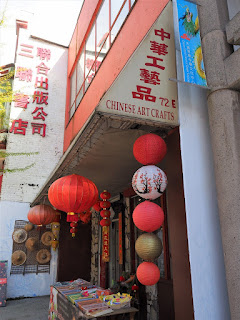





























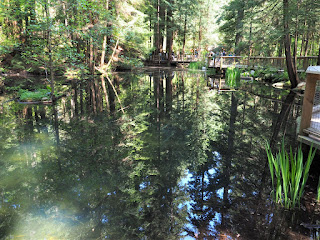



























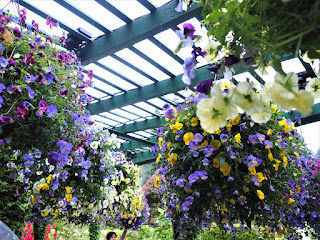






















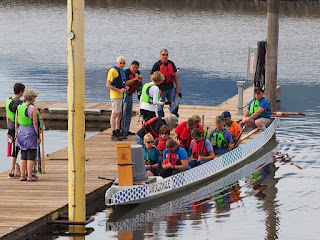






















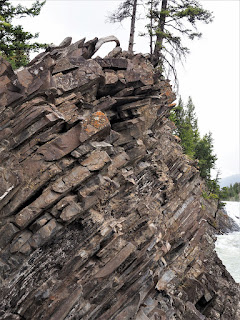

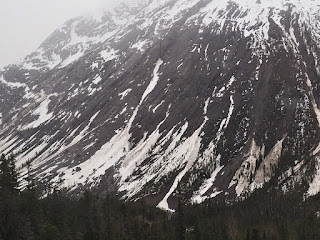





















No comments:
Post a Comment